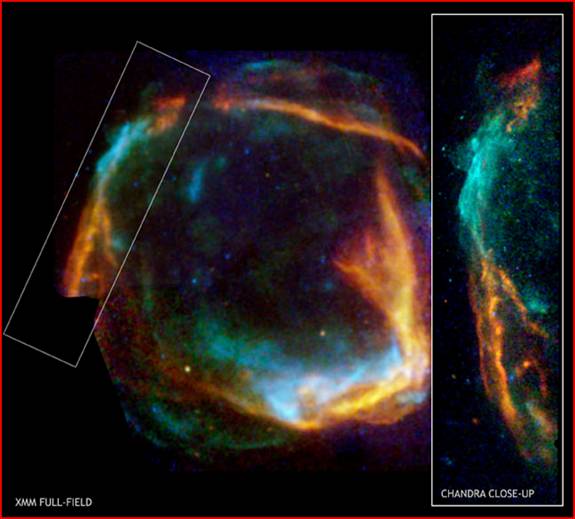
home •
about •
essential guide •
picture of the day •
thunderblogs •
news •
multimedia •
predictions •
products •
get involved •
contact
picture of the day archive subject index
A combined image from the Chandra and XMM-Newton X-ray observatories of RCW 86 shows the
expanding plasma ring around a star in our galaxy, created in a high energy event. Both the
Chandra and XMM images show low energy X-rays in red, medium energies in green and high
energies in blue. Credit: Chandra: NASA/CXC/Univ. of Utrecht/J.Vink et al. XMM-Newton:
ESA/Univ. of Utrecht/J.Vink et al.
Mar 20, 2007
Stellar Ouroboros
Recent close-ups of an undulating ringed nebula (RCW 86) underscore the role of electric discharge in the formation and continuing energetic displays of such structures.
Before the space age, astronomers could look at the stars only in the optical wavelengths that twinkled down to the surface of the Earth. They thought that the rings of luminous haze around some stars (which they called planetary nebulas) were spherical shells of gas expelled when the stars exploded.
With the invention of instruments that could “see” in all wavelengths and that could “look” from above Earth’s atmosphere, the stars—and especially the planetary nebulas—appeared altogether different. The luminous haze resolved into filamentary structures that had hourglass shapes. The structures were composed of plasma, not gas, and they displayed magnetic fields, which caused the plasma to emit synchrotron, not thermal, radiation. (Thermal radiation comes from random motions and collisions of molecules. Synchrotron radiation comes from charged particles spiraling in a magnetic field. The former is driven by heat, the latter by electricity.)
The stars at the centers of these hourglass (plasma pinch) shapes often had disks or rings of plasma around them in their equatorial planes and plumes or jets of collimated, often helical, plasma filaments emerging along their axes. (The space probe Ulysses discovered that even our Sun had such a “donut-on-a-stick” structure.)
The image above emphasizes the ring structure around such stars. Because plasma is composed of some fraction of charged particles, its movement constitutes an electric current. In fact, space plasmas are generally laced with networks of filamentary currents. The rings are toroidal circuits coupled to and driven by the hourglass-shaped current sheets. As such, they are subject to what’s called the “diocotron instability”: The current tends to form vortices along its periphery and to evolve into distorted curlicue shapes. This phenomenon has been documented in many lab experiments and can be observed in auroral curtains.
The diocotron instability in this ring current around RCW 86 has just begun. Part of the first curl is much dimmer than the rest, giving the impression of a snake eating its tail. An ancient symbol for this figure is the ouroboros. Scholars of comparative mythology have found that ancient themes were inspired by events witnessed in the ancient sky. That these events were extraordinary plasma displays has been corroborated by recent findings in the study of rock art: petroglyphs, petrographs, and geoglyphs—rock structures such as Stonehenge—reproduce exactly the forms of plasma discharge instabilities. The conclusion is unavoidable that ancient peoples witnessed the effects of a current surge in the circuits connecting Earth, Sun, and galaxy.
This stellar-scale ouroboros around RCW 86 is probably many orders of magnitude more energetic than the purported “enhanced aurora” in the ancient sky of Earth. But in light of all the artistic, spiritual, and philosophical uses to which the ouroboros has been adapted since its first appearance, this image can serve as a reminder of the ouroboros’s likely origin in an electric sky.
Submitted by Mel Acheson
![]()
home •
thunderblogs •
forum •
picture of the day •
resources •
team •
updates •
contact us
EXECUTIVE EDITORS:
David Talbott, Wallace Thornhill
MANAGING EDITORS:
Steve Smith, Mel Acheson
CONTRIBUTING EDITORS: Michael Armstrong, Dwardu Cardona,
Ev Cochrane,
C.J. Ransom, Don Scott, Rens van der Sluijs, Ian Tresman
WEBMASTER: Brian Talbott
Copyright 2007: thunderbolts.info
